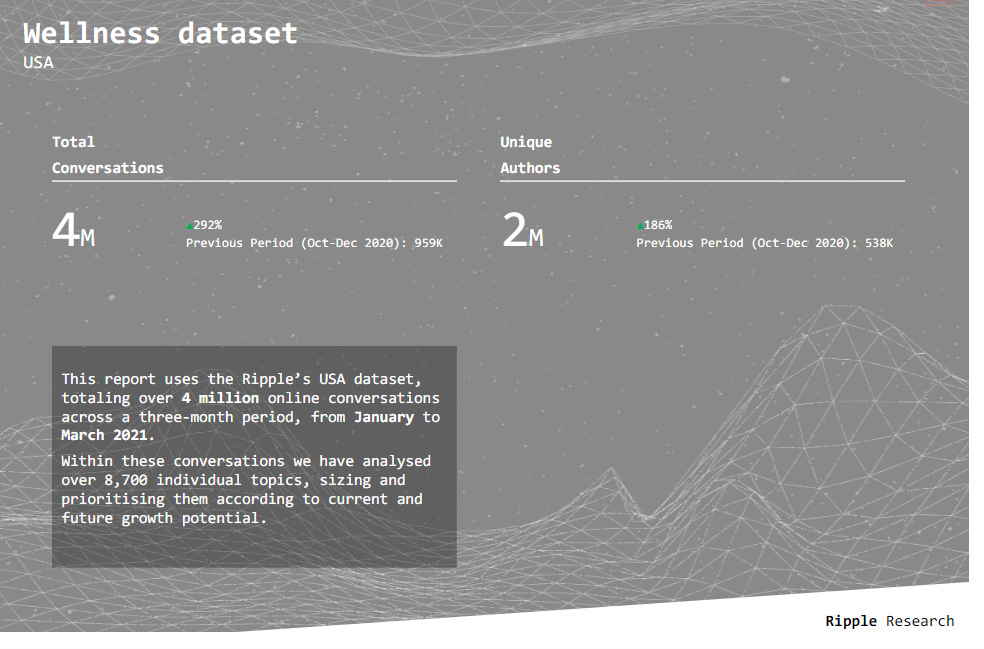Wellness in the USA, Part I: Introduction
An overview of Wellness transitions during the pandemic and why we need innovative methods to investigate them.
Welcome to Track Changes by Ripple Research! Every week, we closely analyse an interesting global event or phenomenon, bringing you a data and analysis-backed perspective on critical public debates. Thank you for reading and subscribing, and we look forward to reading your comments and feedback!
In Part I of our four-part series on Wellness, we briefly examine the ‘Wellness transition’ during the COVID-19 pandemic and the issues with oft-used evaluation mechanisms such as surveys. As the world adjusted to the mental and physical stresses of the pandemic, Wellness took on new forms, generating new niches in the fitness industry and prompting innovative approaches to addressing mental health burdens. In the upcoming Part II, we introduce our Wellness in the USA 2021 dataset and highlight our findings.
Source: Metropolitan Museum of Art
Wellness has transformed dramatically this past year.
A global upheaval in mental health and Wellness was marked by anxiety, uncertainty and anguish. Fundamental activities that human beings undertake to unwind – going to the park, shopping at the mall, playing at school or going to the movies – were curbed entirely, shaking the foundations of human Wellness as we understood it. As countries across the globe gradually came to terms with the reality of the pandemic, commercial activity and restricted social engagements rebounded, marking a pivotal transition for the Wellness industry. In our 4-Part series, Ripple Research analyses what has changed about Wellness in 2021, and how you could intervene sustainably to be a part of that change. We also offer you a bird’s-eye view of the Ripple Wellness in the USA Dataset 2021 – a treasure trove of over 4 million online conversations that tells you how Americans see Wellness and where it’s headed.
Both academic and market research projects have delved into this ‘wellness transition’, attempting to capture how the pandemic has shifted the goalposts of wellbeing. McKinsey’s ‘Feeling Good’ report estimated the size of the wellness industry at USD 1.5 trillion, highlighting six dimensions of personal ‘betterment’ which have created sub-industries and subcultures of their own. Other attempts to understand impacts have focused on the psychopathology of COVID-19. An Oxford-funded study in the Lancet Psychiatry Journal found that 34% of COVID-19 patients were diagnosed with mental health disorders – most commonly anxiety disorders – during or after the infection period. Similarly, a study by Rodriguez-Hidalgo et. al (2020) found that the mental health repercussions of the COVID-19 pandemic were particularly sharp for students in Ecuador and in Latin America in general.
Clearly, Wellness is in flux. Mental Health needs more attention. Anxiety and depression are dominating social media spaces. Fitness and exercise trends grow and change by the day. As Americans search for familiarity and peace of mind in the midst of COVID-19, there are millions of transitions happening simultaneously, sending ripples through social and traditional media and the larger Wellness industry. Research is one thing: it investigates a hypothesis to ascertain if what we think we know about these transitions is true. But how do we generate bottom-up insights? How can we know what everyone is saying and doing? More importantly, how can we know where Wellness is headed in 2021 and beyond? At Ripple Research, we help you uncover these insights by assembling the largest-ever dataset on Wellness for January to March 2021. As COVID-19 forges unpredictable new paths every day, our data tells you how Wellness in all its forms is changing.
Two observations arise. First, ‘Wellness’ is a broad category, spanning everything from food and lifestyle to medicine and research. Second, the primary method used to glean insights into Wellness is the survey method, sometimes supplemented by examinations of databases, sales and growth trajectories.
How can we analyse Wellness in this context? Surveys are limited by their sample size. Patient or consumer databases only tell us what steps people are taking, without giving any indication of future trends or emerging conversations. A robust analytical methodology that captures interpersonal expressions of emotion or opinion on Wellness-related issues could yield far deeper insights into the future of the Wellness industry. In this Series, we do just that- large-scale Sentiment Mining and data analysis to tell you where Wellness is and where it’s headed.
Ripples in Wellness
At Ripple Research, we use state-of-the-art sentiment mining and Natural Language Processing Tools to uncover what people are saying about wellness, how they are responding to the world around them (positive/negative sentiments) and trends across time. Our advanced analytical tools are capable of processing several million social media impressions, stratified for vocabulary, reach and origin right down to the minute. For this analysis, we examine the dominant narratives within global conversations on Wellness – along the dimensions listed above and more – between January and March 2021. We picked this phase for two reasons. First, it may be described as a ‘mature’ phase of the pandemic- COVID-19 has been around for over a year, forcing communities to live with restrictions and identify routes towards wellness that are sustainable in the long term. The social media interactions we delve into tell us how some of these routes - such as Wellness Apps – are getting exponentially more popular by the day. Second, as vaccinations ramp up and a potential end to the pandemic comes into view, a cautious optimism may be expected within this period of immense societal churn. Is this backed by the data? Are people really feeling better about themselves and looking forward to a future defined by Wellness? We investigate in our 2021 Wellness Dataset.
Here’s an overview of our sizeable dataset, which we’ll analyse in detail in our next post:
Stay Tuned for Part II of our Series on Wellness.
If you liked this post, click Subscribe to receive more like it directly in your mail inbox! We’d love to hear your feedback and comments.

